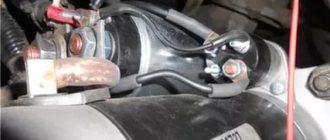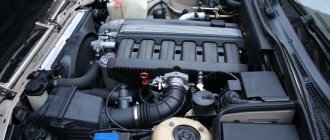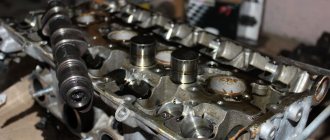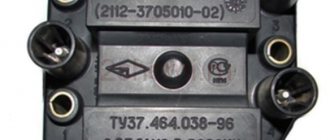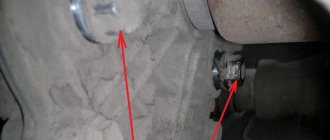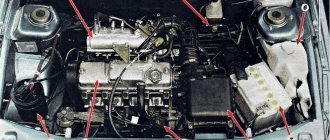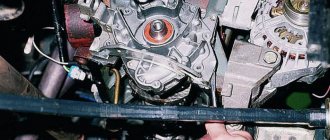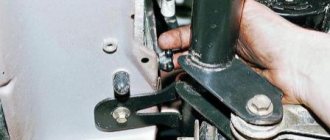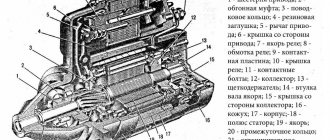Why does the 16-valve VAZ-2112 stall when accelerating?
Repeatedly, many drivers were faced with the fact that the 16-valve VAZ-2112 began to become dull during acceleration or a drop in speed was felt. This may be due to various reasons that you need to know how to eliminate.
The video shows the process when a VAZ-2112 was tripping, did not pick up speed well, the check engine light came on periodically, and a solution:
Signs of engine tripping
Regardless of the reasons, engine tripping is associated with the presence of various problems, which can be solved after finding out what caused the stoppage of one of the cylinders of the internal combustion engine.
The main signs of engine tripping include
Signs
Auto mechanics identify several reasons why jerking occurs and the engine begins to stall. The main ones are: incorrect ignition timing, faulty spark plugs and installed condenser, broken piston rings, piston and valve burnout, rocker wear, clogged air filter, and others.
Why is it stupid? Basic faults
Type of VAZ-2112 engine
There are not many reasons for the effect when the 16-valve engine on the VAZ-2112 16 valves stalls. Of course, you will have to tinker a little in order to find the true reason in one case or another, but otherwise there is a direct road to a car service center. For those who have decided to repair their car themselves, this information will be useful.
So, let's look at the main reasons for this effect:
We clean the sensor from dirt and dismantle it.
The main reasons are considered, and you can move on to solving these problems.
Methods for solving the problem
To eliminate failure during overclocking, you need to check all the components listed below step by step. This is a considerable amount of work, but the car enthusiast will be able to save a sufficient amount of money, which would have been charged to him at a car service center. Of course, for those who don’t understand the design of a car, that’s the way to go, or ask your friends who will fix the problems for half the price. But, if you follow the instructions, you can figure it out yourself.
Poor quality fuel
Poor quality fuel is a common cause of engine breakdowns
Of course, in our country, low-quality fuel causes many misfortunes and troubles for motorists. It is not possible to check the fuel at a gas station, so everyone is already struggling with the consequences. The only thing that can be done is to carry out regular diagnostics and cleaning of the fuel system.
Fuel system
Injectors on the fuel rail removed from the engine
The first line of engine protection is fuel filters, which sometimes fail and not enough fuel gets into the engine. On the other hand, when completely clogged, the injectors are clogged, which at low speeds give a normal amount of mixture, but if the engine is accelerated, the amount of mixture remains the same and a failure appears at low speeds.
The way out of the situation is to replace the fuel filter, clean or replace the gasoline pump mesh, and diagnose and replace failed injectors. The latter usually go through a cleaning stage, but this does not always help and they have to be replaced.
Throttle valve
Cleaned throttle body
A stuck throttle valve and insufficient air supply can cause the engine to become sluggish when accelerating. This is due to a non-optimal fuel mixture. In this case, the solution to the problem is cleaning.
Ignition system
High voltage wires of the ignition system
Electrical problems
The reasons why the engine does not pick up speed may also lie in various defects in the fuel system, which lead to air being sucked in through depressurized areas (broken hoses, leaky washers), which has an extremely detrimental effect on the operation of the fuel system.
On injection engines, it is necessary to determine how the timing marks are set, since the timing of ignition and injection of the fuel mixture depends on this. You also need to check the tension of the timing belt, as well as the correctness of its installation, since its incorrect fit and installation of teeth can also affect the development of power of the car engine itself.
After checking the fuel system, the engine ignition system follows. The first step is to check the condition of the spark plugs, especially their tips. Pay attention to the spark plug insulators: if they have longitudinal brown deposits on them, they must be replaced immediately. If the tips are carbon deposited, it must be removed and cleaned.
For this purpose, you can use coarse sandpaper. Now you need to carefully examine the condition of the distributor and high-voltage wires. Then it will be necessary to measure the wires so that one of them does not have too much resistance, or that there is no break in it.
Causes of poor speed gain
General view of the engine under the hood
So, let's look at what the problem is and where exactly you need to look for it:
- Fuel pump and pressure.
- Injectors.
- Fuel rail.
- Ignition system.
- Electronic control unit.
Now that all the causes are predetermined, you can begin sequential diagnosis and methods for solving the problem.
Options for solving the problem
To diagnose all of the above systems you will need a set of wrenches and screwdrivers, a tester, a little knowledge and hands growing from the right place. The main task remains to correctly distribute the sequence of operations. This is exactly what we will talk about next. So, let's look at where we need to go to remove the effect that has arisen.
Fuel pump, filter, rail and injectors
Fuel pump in the process of disassembly and diagnostics
First of all, for diagnostics it is necessary to diagnose the gasoline module (pump). If the car drives at high speeds, then everything is fine with the pump itself, but the problem may lie in the filter mesh . For inspection, you will have to remove the fuel pump and replace the cleaning screen on it, which is primarily responsible for purifying gasoline. Most likely, it is dirty and needs to be replaced.
General view of the fuel filter
The second problem may be the fuel filter, which needs to be replaced. It is often dirty and needs to be replaced. After the first two elements of the fuel system have been replaced, you can try to drive it and see if the problem goes away.
General view of the fuel rail with injectors
If, nevertheless, the car continues to gain momentum poorly, then you need to crawl under the hood and look for the problem directly in the fuel injection system. To do this, you need to measure the pressure in the fuel rail.
To do this, dismantle the fuel rail with injectors and disassemble the assembly. The first element must be checked for leaks. Injectors are often installed on a special stand, cleaned and diagnosed. If necessary, all damaged elements are replaced.
Ignition
Unscrewing the spark plugs from the engine
If the fuel system has been checked and is working properly, then you need to look for a problem in the ignition system. So, the high-voltage wires are dismantled and the spark plugs are unscrewed. Both elements are checked using a tester .
Of course, it is best to diagnose spark plugs on a special spark plug stand. As practice shows, the problem in 50% of cases lies precisely in this unit, so after checking it is necessary to replace the damaged elements. We conducted a special survey on the choice of candles.
Interior and body
High-quality assembly of a car interior is clearly not about the VAZ-2110. Rattling, “crickets” and squeaks in the interior of this car are present from the factory. The owners either put up with this or begin a complete overhaul of the interior.
Another disadvantage in the cabin is the heating and ventilation system. The interior heater very often stops performing its functions.
And finally – the body.
Among the main problems with the body, we can note the weak anti-corrosion treatment of the bottom, as well as the lack of plugs in technological holes, which is why corrosion often forms in these holes.
Additionally, corrosion may appear near the windshield seals. This applies to all models of the 10th family.
As for models 2111 and 2112, they have more problems with the body than the sedan.
The rear door of these models often rattles a lot. Crickets in the trunk are common. Corrosion on the tailgate appears very often.
On a VAZ-2111, when closing the rear door, the reflector may be destroyed. Also, the paint on the roof rails of this model quickly flies off, especially on the A-pillars.
conclusions
Determining and eliminating the causes of poor speed of the 16-valve VAZ-2112 engine is quite a difficult matter. It is necessary to go through each node step by step, which may be the cause of the malfunction. Well, if the motorist was unable to diagnose the problem on his own, then it is recommended to contact a car service center, where specialists will quickly determine what the problem is and fix it.
Guys, tell me, well, in short, I washed the injectors and installed the ramp. Then, for various reasons, I had to remove the ramp 10 times. Then there was a problem with gas. When you press the pedal lightly (at any speed and at any rpm), the car behaves calmly. When you sharply press the pedal to the floor (well, when overtaking or in competitions), you feel like the car is sort of choking on gasoline. It seems to stop accelerating as expected. And the harder you press, the more stupidly the car clamps. Consumption has also increased. I filled the amplifier into the tank, the car seemed to come to life, but sometimes I felt jolts when I pressed the pedal for the first time.
While operating their car, many drivers begin to notice that the engine does not gain speed properly. Accordingly, the dynamics decrease, the possibilities of maneuvering and overtaking are reduced. This problem cannot be tolerated.
Turnovers are not growing
Prevention is better than repair
But first of all, it is necessary to find an answer to the question of why the VAZ-21124 jerks during acceleration. On the face of it, it doesn't seem like a very ordinary question. But in fact, such twitching becomes not funny at all. You start to feel especially creepy when the VAZ-21124 jerks during acceleration and the check light comes on. Trouble has become reality.
It has long been known that any breakdown is easier to prevent than to fix. Therefore, try to pay more attention to your vehicle while driving. And here a problem arises: not every driver can feel the car and determine the cause in time.
You should immediately decide on the sequence of actions:
- Checking the car for twitching while idling is unacceptable. This should only be done when moving.
- The check should begin on the smoothest and least dangerous section of the route, where there is no heavy traffic.
- To check, start shifting gears one by one by pressing the gas pedal on each gear.
- If the vehicle begins to jerk without your participation, therefore, the root cause of the problem must be sought in this problem.
Causes
There may be several reasons for the lack of proper speed gain:
- There are problems with the air supply;
- The ignition has failed;
- Fuel system malfunctions have occurred;
- There were problems with the exhaust system.
Fuel system problems are common in gasoline engines. They are the most common. Therefore, you should start with checking it.
Fuel system
If problems arise when accelerating the car, start checking by inspecting the fuel system.
- Most often, the engine stops gaining momentum because the fuel pump fails. At first, this may have a slight effect, sometimes unnoticed. Over time, as the pump wears out, the speed and power will begin to drop, and the acceleration dynamics will decrease.
- If the fuel pump is partially damaged, it still partially performs its functions, but is no longer capable of delivering the same volumes of fuel. This results in fuel starvation and power loss.
- The best solution to a problem with the pump is to replace it. It is better to trust repairs to specialists.
Ignition
If the ignition fails, you will have to conduct a comprehensive check of all system components that may cause a drop in engine power and speed.
What to check
Checking VAZ-2107
Now let's take a closer look at how to identify the cause of such a malfunction on different car models.
The first will be the carburetor VAZ-2107; there are plenty of cases when the car suddenly starts to jerk while driving.
- First you need to inspect all pipes of the system for cracks;
- Open the tank. It happens that in the summer the lid fits very tightly to the neck, blocking the access of air to the tank. When moving, the pump works and creates a vacuum in the tank, due to which the same pump is then unable to “pull” fuel. It seems like a small thing, but this also happens;
- Inspect the fuel filter located in the pipes leading to the fuel pump. These filters are transparent and easy to visually evaluate;
- You can also check the fuel pump without removing it. It is necessary to disconnect the pipeline coming from the pump from the carburetor and lower its end into some container. Then manually pump the pump into action and evaluate how it pumps fuel - it should supply it in even portions;
- While the fuel pipe is disconnected from the carburetor, unscrew the fitting on which the fuel line fits and remove the small mesh filter, clean it and reinstall it;
- Next comes the carburetor. It is advisable to remove it from the car, rinse it thoroughly, and inspect the accelerator pump membrane.
If actions with the fuel system did not help, we proceed to checking the ignition system.
We unscrew the spark plugs, check their functionality, and replace them if necessary; We check the system wiring for breakdown. This can be done this way - in the dark or in a closed garage (the main thing is that it is dark), open the hood and start the engine. If there are voltage losses on the wiring, they will be immediately noticeable by the sparks that form. Next, we replace the wiring that “breaks through” and check the wire connections; Next, we check the distributor, there should be no signs of critical wear, it should be dry under the cover. Be sure to inspect the centrifugal regulator, and also check the vacuum regulator. You should check whether there is a vacuum in the pipe leading to it. Then the Hall sensor, coil and switch will be checked for functionality. You can do this yourself if you have the necessary equipment at hand, but you need to know how to check them
But you can contact an auto electrician. It is also important not to forget to check that the ignition is installed correctly.
This is in general and all the features of identifying the cause of uneven running on the VAZ-2107.
The engine does not pick up speed VAZ 2110 injector 8 valves. It's gaining momentum very poorly
1) Greetings, Happy New Year. car VAZ 2114, engine 1.6 8 valves. I don’t understand where to dig, it picks up speed very poorly, the slipper is on the floor, but it doesn’t react, then it picks up slowly, and you squeeze the clutch, it may either stall or it will idle at 520-630 revolutions and the sound is like the Cossacks, like a pot doesn't work, Jackie Chan doesn't burn. Tell me where to start digging Question from: @id1822769 Separate topic: 2) guys, such a story! VAZ 21074. The eight-wheel carburetor has an idle speed solenoid valve on it! So I decided to change it because the revolutions began to jump! a wire is connected to the solenoid valve, so that’s the rub, I remembered the valve, the speed also jumps, and now in addition to this, when the wire is disconnected from the valve, the car continues to work at very low speeds, but it works! ps before, when the wire was disconnected, the engine immediately stalled. Well, who can advise or help))) (I’ll tell you right away, I’ve already changed 3 of these valves, the result is the same) Question from: @id183726641 Separate topic: Write the number of the question you’re answering! To the authors of questions: be sure to write in the comments how you solved your problem! The engine does not pick up speed VAZ 2110 injector 8 valves.

